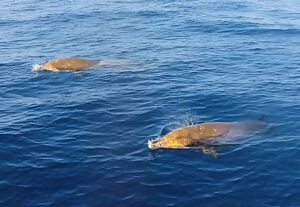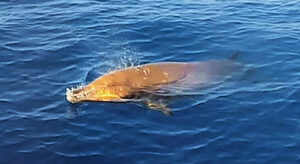Blainville’s Beaked Whale, Mesoplodon densirostris

 Blainville’s Beaked Whale, Mesoplodon densirostris. Photographs taken in coastal waters off Kona, Hawaii, September 2015. Photography and identification courtesy of Bob Hillis, Ivins, Utah.
Blainville’s Beaked Whale, Mesoplodon densirostris. Photographs taken in coastal waters off Kona, Hawaii, September 2015. Photography and identification courtesy of Bob Hillis, Ivins, Utah.
Phylogeny: Blainville’s Beaked Whale, Mesoplodon densirostris (Blainville, 1817), is a member of the Ziphiidae Family of Beaked Whales. It has also been known as the dense-beaked whale. Within the Mesoplodon genus, the Blainville’s Beaked Whale is the msot prevalent.
Morphology: They have robust bodies and a head with a moderately long beak, and the mouth line makes a sharp curve up at its midpoint. In mature males, large teeth extend from the lower jaw, above the upper jaw, that may have barnacles attached. The dorsal fin is small and triangular or falcate and lies about two-thirds of the way back on the body and the flippers are small. Dorsally these whales are dark gray transitioning to lighter gray ventrally. They have brownish heads and some have tan or lighter gray blotches. Many are marked with round, white, scars that originate from Cookiecutter Shark bites. They have lower jaws that are unusually dense, denser than elephant ivory. It is thought that this may be necessary for strength in violent conflicts between males of the species, or that it may improve acoustic accuracy for echo location. The species is known for making a very little splash when they surface, though it lifts much of its head out of the water. Females may reach a maximum 4.6 m (15 feet) in length and 1,000 kg (2,200 lbs) in weight; the males are smaller with a maximum of 4.4 m (14 feet 6 inches) in length and 800 kg (1,800 lbs) in weight.
Habitat & Distribution: Blainville’s Beaked Whales Is an open ocean species with a wide distribution in temperate and tropical seas that is usually found in small groups of two to seven individuals at depths up to 500 m (1,640 feet). However, they have also been at depths of 1,520 m (4,986 feet). They are found along both the Atlantic and Pacific coasts of Mexico, including throughout the Sea of Cortez.
Reproduction: Blainville’s Beaked Whales are sexually dimorphic. The males often fight to compete for females, using their tusk-like teeth within their dense jaws. The species is thought to form harems, with a dominant male and several females. Sexual maturity occurs at approximately nine years old. Females give birth to a single calf when pregnant, that can be 2.6 m (9 feet) in length and 60 kg (132 lbs) in weight.
Diet: The Blainville’s Beaked Whale sis species feeds in deep water and can dive from 500 to 1,000 meters and can remain submerged for up to 45 minutes. They are carnivores with their diet typically including but is not limited to cephalopods, armhook squid, and cock-eyed squid.
Synonyms: Delphinus densirostris, Nodus densirostris, and Ziphius sechellensis.